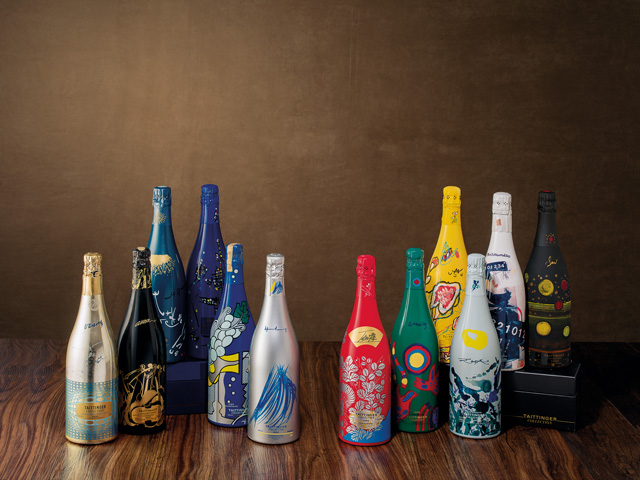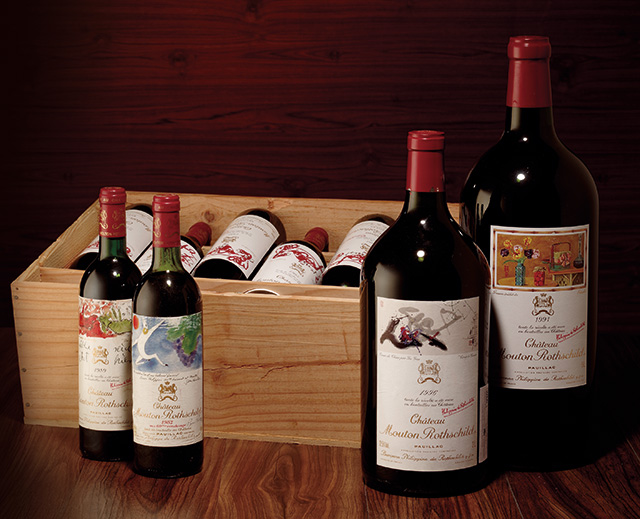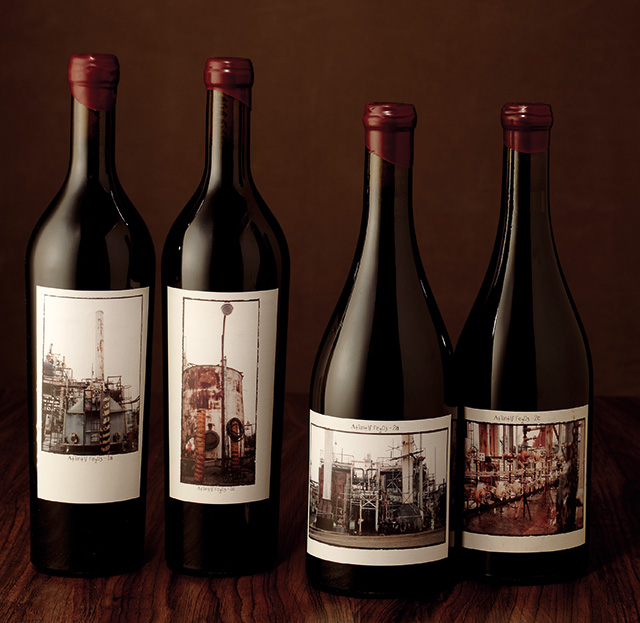Art Column
The Art of Wine Label
Eva Tang / Ravenel Quarterly No. 24 Spring 2018 / 2018-04-17
Wine is a feast of the smell and taste, while the wine label epitomizes the spirit of the wine estate, the ideals of the winemakers, and transforms smell and taste into visual and emotive expressions. It presents a series of signals and hints that tease the endless imagination of the wine connoisseur before the cork has left the bottle.
The history behind the design of wine labels is only a century old. In the early days after the mass production of glass bottles begun, the wine bottles were merely marked in chalk with the place of origin and year of production. Later on, when distributors responsible for the sale of the wine began to place labels on the bottles, wine labels were deemed as a means to convey identity and information. As the competition between wine producers grew, wine labels also entered the fray and opened up new strategic models for the wine market. The design of the wine labels, the shape of the bottles, and even the external packagings are what create the first impression of the wine. In the creation of a long-lasting impression on the consumers during the short duration of the first impression in order to enable the consumers to experience the story behind the bottle of wine and its one-of-a-kind value, the design of wine labels has time and again offered surprising presentations and combinations.
Among these, the design of wine labels has always been closely linked to the arts. British artist Tracey Emin, known for her installation artwork "My Bed", created the wine labels for the Tonnix product range for Quinta de la Rosa wine estate of Portugal. Château Fonroque of Saint-Émilion in the Bordeaux region of France commissioned British artist Peter Doig, famed for his fantastical landscapes created through abstract colors and light and shadow play, to create the wine label for their biodynamic, naturally-farmed wine Cælestis in 2011. The original artwork sold for £40,000 at a charity auction in London in 2015.

In addition, Taittinger, the champagne producer founded in 1734 launched its master's collection "Collections de Maitres" in 1973, every year, an artist is invited to design the bottle and the image on the packaging box. For the 1978 vintage of this collection, the Hungarian-born French "leader" of the optical art movement Victor Vasarely was invited; for 1981, it was the French pioneer of New Realism Arman; for 1985, it was the US pop art icon Roy Lichtenstein; later artists included renowned figures such as Hans Hartung, Toshimitsu Imai, Corneille, and Zao Wou- ki. The combination of unique artworks and the distinct provenance of the wine (due to both natural and human factors) has created the one-of- a-kind characteristics and flavors of each bottle of wine from each year. It has enhanced the collectible value of the wine and transformed the wine into an art piece to be enjoyed, while the special wine labels receive as much attention from collectors as that paid to out-of-print stamps.
Now, let us visit two world-renowned wine estates famous for their flawless wine quality and the artistic wine labels.

Château Mouton
Château Mouton is ranked one of the top five wine estates in the Bordeaux region of France, it is located in the village Pauillac in the Medoc region. In 1973, it was upgraded from a second-class wine estate to a first-class Bordeaux wine estate. Château Mouton's flagship wine, rated by Robert M. Parker Jr. as "a wine that surpasses 100 points and has broken past the ultimate boundaries of taste" was not only a wine that was bursting with passion and abandon, full-bodied with well-rounded and luxurious texture, it was also the pioneer of the artistic wine labels. This all started when Baron Philippe de Rothschild took over control of the wine estate in 1922. The baron enjoyed literature, art, and theater, and in order to celebrate the birth of the first bottle of wine - Château Mouton 1924 - after he took over the business, he invited a renowned poster designer of that time, Jean Carlu, to design the wine label. The bright color-block design represented the five arrows on the Rothschild family's coat-of-arms and the sheep that represent Château Mouton. When WWII ended in 1945, Baron Rothschild was inspired by the victory of the WWII Allies and he decided to use the wine label of that year to commemorate the joy of regained freedom. He commissioned Philippe Jullian, who later became an important figure in theater, to use the "V for Victory" hand gesture created by British Prime Minister Winston Churchill to serve as encouragement to freedom during WWII, as the key design feature to create a historically significant art wine label. Since that year, the wine estate has collaborated with a renowned artist every year to design the wine label, each unique wine label tells the tale behind the vintage of that particular year. If one goes carefully through the wine labels of Château Mouton, it is like reading a scaled-down version of contemporary art history. There is Georges Braque (1955), Pablo Picasso (1973), and Marie Laurencin (1948) of Cubism; Joan Miró (1969), Salvador Dali (1958), Francis Bacon (1990), and Lucian Freud (2006) of Surrealism; Wassily Kandinsky (1971) and Robert Motherwell (1974) of Abstract art; Andy Warhol (1975) of pop art; and Marc Chagall (1970) who explored impressionist cubism and abstract expressionism. Each of these artists is key players on the stage of art history.
Château Mouton is much sought after in the auction markets around the world, when compared to Lafite or Latour, also in the top five wine estates ranking, over half a century of continuous collaboration with artists means that collecting the fine nectars of Château Mouton also means the collection of an incomparable visual feast. Since the value of the collection is enhanced, the collectors are of cause even more dedicated.

Sine Qua Non
Cult Wine is a legend in the world of wine. It does not refer to specific vintages or wine estates, it is actually a concept and trend that started in the 1980s. Cult wines proved to the world that in addition to large-scale production of wines by North America, Australia, Italy, and Spain, these places are also able to produce high-quality boutique wines. The common feature that all cult wines share is their low production volume, when compared to the over 30000 cases produced annually by Château Lafite, cult wines have a production volume of merely a few hundred cases per year. Under the market strategy of rarer the commodity the higher the price and the high points awarded by wine critics such as Robert Parker, cult wine was born in the Napa Valley in California, US, followed on by the founding of wineries including Screaming Eagle, Harlan Estate, and Diamond Creek. In the mid-1990s, the prices of cult wines continued to create new world records, after a few change of hands and public auctions, a bottle of wine could go for as much as USD10000, which far surpassed that of ranked Bordeaux wine estates and even the price of wines from the top five wine estates. Sine Qua Non is not only the cream of the crop out of the cult wine trend, it is also recognized as the most difficult wine to be procured.
Sine Qua Non was founded by the Austrian immigrant Manfred Krankl and its first wine "Queen of Spades" was created in 1994. In California, US where Cabernet Sauvignon is the mainstream, the main products of Sine Qua Non are instead Syrah and Grenache from the Rhone region. Even more interestingly, the winery owner is of the opinion that the wine from each year is unique so each should have their own independent status symbol. So even if the cultivar is the same, for each variety of wine from every year, the winery owner himself would design different labels and give them uncommon and unusual names, and even break through tradition by using different types of glass bottles. The outstanding wine quality, the extremely low production volume, and the one-of-a-kind wine labels have turned the attention of the collectors on to Sine Qua Non and to viewing it as a collectible art. The difficulty in collecting the entire range meant that the market price of Sine Qua Non climbed exponentially.
The history behind the design of wine labels is only a century old. In the early days after the mass production of glass bottles begun, the wine bottles were merely marked in chalk with the place of origin and year of production. Later on, when distributors responsible for the sale of the wine began to place labels on the bottles, wine labels were deemed as a means to convey identity and information. As the competition between wine producers grew, wine labels also entered the fray and opened up new strategic models for the wine market. The design of the wine labels, the shape of the bottles, and even the external packagings are what create the first impression of the wine. In the creation of a long-lasting impression on the consumers during the short duration of the first impression in order to enable the consumers to experience the story behind the bottle of wine and its one-of-a-kind value, the design of wine labels has time and again offered surprising presentations and combinations.
Among these, the design of wine labels has always been closely linked to the arts. British artist Tracey Emin, known for her installation artwork "My Bed", created the wine labels for the Tonnix product range for Quinta de la Rosa wine estate of Portugal. Château Fonroque of Saint-Émilion in the Bordeaux region of France commissioned British artist Peter Doig, famed for his fantastical landscapes created through abstract colors and light and shadow play, to create the wine label for their biodynamic, naturally-farmed wine Cælestis in 2011. The original artwork sold for £40,000 at a charity auction in London in 2015.

In addition, Taittinger, the champagne producer founded in 1734 launched its master's collection "Collections de Maitres" in 1973, every year, an artist is invited to design the bottle and the image on the packaging box. For the 1978 vintage of this collection, the Hungarian-born French "leader" of the optical art movement Victor Vasarely was invited; for 1981, it was the French pioneer of New Realism Arman; for 1985, it was the US pop art icon Roy Lichtenstein; later artists included renowned figures such as Hans Hartung, Toshimitsu Imai, Corneille, and Zao Wou- ki. The combination of unique artworks and the distinct provenance of the wine (due to both natural and human factors) has created the one-of- a-kind characteristics and flavors of each bottle of wine from each year. It has enhanced the collectible value of the wine and transformed the wine into an art piece to be enjoyed, while the special wine labels receive as much attention from collectors as that paid to out-of-print stamps.
Now, let us visit two world-renowned wine estates famous for their flawless wine quality and the artistic wine labels.

Château Mouton
Château Mouton is ranked one of the top five wine estates in the Bordeaux region of France, it is located in the village Pauillac in the Medoc region. In 1973, it was upgraded from a second-class wine estate to a first-class Bordeaux wine estate. Château Mouton's flagship wine, rated by Robert M. Parker Jr. as "a wine that surpasses 100 points and has broken past the ultimate boundaries of taste" was not only a wine that was bursting with passion and abandon, full-bodied with well-rounded and luxurious texture, it was also the pioneer of the artistic wine labels. This all started when Baron Philippe de Rothschild took over control of the wine estate in 1922. The baron enjoyed literature, art, and theater, and in order to celebrate the birth of the first bottle of wine - Château Mouton 1924 - after he took over the business, he invited a renowned poster designer of that time, Jean Carlu, to design the wine label. The bright color-block design represented the five arrows on the Rothschild family's coat-of-arms and the sheep that represent Château Mouton. When WWII ended in 1945, Baron Rothschild was inspired by the victory of the WWII Allies and he decided to use the wine label of that year to commemorate the joy of regained freedom. He commissioned Philippe Jullian, who later became an important figure in theater, to use the "V for Victory" hand gesture created by British Prime Minister Winston Churchill to serve as encouragement to freedom during WWII, as the key design feature to create a historically significant art wine label. Since that year, the wine estate has collaborated with a renowned artist every year to design the wine label, each unique wine label tells the tale behind the vintage of that particular year. If one goes carefully through the wine labels of Château Mouton, it is like reading a scaled-down version of contemporary art history. There is Georges Braque (1955), Pablo Picasso (1973), and Marie Laurencin (1948) of Cubism; Joan Miró (1969), Salvador Dali (1958), Francis Bacon (1990), and Lucian Freud (2006) of Surrealism; Wassily Kandinsky (1971) and Robert Motherwell (1974) of Abstract art; Andy Warhol (1975) of pop art; and Marc Chagall (1970) who explored impressionist cubism and abstract expressionism. Each of these artists is key players on the stage of art history.
Château Mouton is much sought after in the auction markets around the world, when compared to Lafite or Latour, also in the top five wine estates ranking, over half a century of continuous collaboration with artists means that collecting the fine nectars of Château Mouton also means the collection of an incomparable visual feast. Since the value of the collection is enhanced, the collectors are of cause even more dedicated.

Sine Qua Non
Cult Wine is a legend in the world of wine. It does not refer to specific vintages or wine estates, it is actually a concept and trend that started in the 1980s. Cult wines proved to the world that in addition to large-scale production of wines by North America, Australia, Italy, and Spain, these places are also able to produce high-quality boutique wines. The common feature that all cult wines share is their low production volume, when compared to the over 30000 cases produced annually by Château Lafite, cult wines have a production volume of merely a few hundred cases per year. Under the market strategy of rarer the commodity the higher the price and the high points awarded by wine critics such as Robert Parker, cult wine was born in the Napa Valley in California, US, followed on by the founding of wineries including Screaming Eagle, Harlan Estate, and Diamond Creek. In the mid-1990s, the prices of cult wines continued to create new world records, after a few change of hands and public auctions, a bottle of wine could go for as much as USD10000, which far surpassed that of ranked Bordeaux wine estates and even the price of wines from the top five wine estates. Sine Qua Non is not only the cream of the crop out of the cult wine trend, it is also recognized as the most difficult wine to be procured.
Sine Qua Non was founded by the Austrian immigrant Manfred Krankl and its first wine "Queen of Spades" was created in 1994. In California, US where Cabernet Sauvignon is the mainstream, the main products of Sine Qua Non are instead Syrah and Grenache from the Rhone region. Even more interestingly, the winery owner is of the opinion that the wine from each year is unique so each should have their own independent status symbol. So even if the cultivar is the same, for each variety of wine from every year, the winery owner himself would design different labels and give them uncommon and unusual names, and even break through tradition by using different types of glass bottles. The outstanding wine quality, the extremely low production volume, and the one-of-a-kind wine labels have turned the attention of the collectors on to Sine Qua Non and to viewing it as a collectible art. The difficulty in collecting the entire range meant that the market price of Sine Qua Non climbed exponentially.